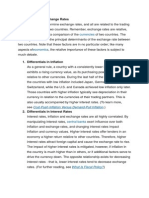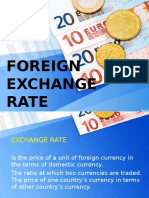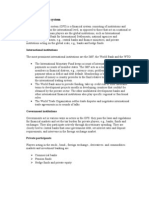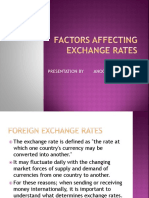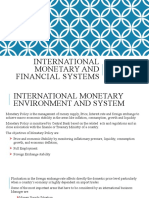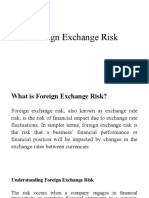Exchange Rates Foreign-Exchange Rate, Forex Rate or FX Rate)
Exchange Rates Foreign-Exchange Rate, Forex Rate or FX Rate)
Uploaded by
SaadRasheedCopyright:
Available Formats
Exchange Rates Foreign-Exchange Rate, Forex Rate or FX Rate)
Exchange Rates Foreign-Exchange Rate, Forex Rate or FX Rate)
Uploaded by
SaadRasheedOriginal Description:
Original Title
Copyright
Available Formats
Share this document
Did you find this document useful?
Is this content inappropriate?
Copyright:
Available Formats
Exchange Rates Foreign-Exchange Rate, Forex Rate or FX Rate)
Exchange Rates Foreign-Exchange Rate, Forex Rate or FX Rate)
Uploaded by
SaadRasheedCopyright:
Available Formats
Factor that effect exchange rate
EXCHANGE RATES
In finance, an exchange rate (also known as the
foreign-exchange rate, forex rate or FX rate)
between two currencies is the rate at which one
currency will be exchanged for another. It is also
regarded as the value of one countrys currency in
terms of another currency.[1] For example, an interbank exchange rate of 91 Japanese yen (JPY, ) to
the United States dollar (US$) means that 91 will be
exchanged for each US$1 or that US$1 will be
exchanged for each 91.
Factors that affect exchange rates
1. Differentials in Inflation
As a general rule, a country with a consistently lower
inflation rate exhibits a rising currency value, as its
purchasing power increases relative to other
currencies. During the last half of the twentieth
century, the countries with low inflation included
Japan, Germany and Switzerland, while the U.S. and
Canada achieved low inflation only later. Those
countries with higher inflation typically see
depreciation in their currency in relation to the
currencies of their trading partners. This is also
usually accompanied by higher interest rates.
2. Differentials in Interest Rates
Factor that effect exchange rate
Interest rates, inflation and exchange rates are all
highly correlated. By manipulating interest
rates, central banks exert influence over both
inflation and exchange rates, and changing interest
rates impact inflation and currency values. Higher
interest rates offer lenders in an economy a higher
return relative to other countries. Therefore, higher
interest rates attract foreign capital and cause the
exchange rate to rise. The impact of higher interest
rates is mitigated, however, if inflation in the country
is much higher than in others, or if additional factors
serve to drive the currency down. The opposite
relationship exists for decreasing interest rates - that
is, lower interest rates tend to decrease exchange
rates.
3. Current-Account Deficits
The current account is the balance of trade between
a country and its trading partners, reflecting all
payments between countries for goods, services,
interest and dividends. A deficit in the current
account shows the country is spending more on
foreign trade than it is earning, and that it is
borrowing capital from foreign sources to make up
the deficit. In other words, the country requires more
foreign currency than it receives through sales of
exports, and it supplies more of its own currency
than foreigners demand for its products. The excess
demand for foreign currency lowers the country's
exchange rate until domestic goods and services are
cheap enough for foreigners, and foreign assets are
Factor that effect exchange rate
too expensive to generate sales for domestic
interests.
4. Public Debt
Countries will engage in large-scale deficit financing
to pay for public sector projects and governmental
funding. While such activity stimulates the domestic
economy, nations with large public deficits and debts
are less attractive to foreign investors. The reason? A
large debt encourages inflation, and if inflation is
high, the debt will be serviced and ultimately paid off
with cheaper real dollars in the future.
In the worst case scenario, a government may print
money to pay part of a large debt, but increasing the
money supply inevitably causes inflation. Moreover,
if a government is not able to service its deficit
through domestic means (selling domestic bonds,
increasing the money supply), then it must increase
the supply of securities for sale to foreigners, thereby
lowering their prices. Finally, a large debt may prove
worrisome to foreigners if they believe the country
risks defaulting on its obligations. Foreigners will be
less willing to own securities denominated in that
currency if the risk of default is great. For this reason,
the country's debt rating (as determined by Moody's
or Standard & Poor's, for example) is a crucial
determinant of its exchange rate.
5. Terms of Trade
Factor that effect exchange rate
A ratio comparing export prices to import prices, the
terms of trade is related to current accounts and
the balance of payments. If the price of a country's
exports rises by a greater rate than that of its
imports, its terms of trade have favorably improved.
Increasing terms of trade shows greater demand for
the country's exports. This, in turn, results in rising
revenues from exports, which provides increased
demand for the country's currency (and an increase
in the currency's value). If the price of exports rises
by a smaller rate than that of its imports, the
currency's value will decrease in relation to its
trading partners.
6. Political Stability and Economic Performance
Foreign investors inevitably seek out stable countries
with strong economic performance in which to invest
their capital. A country with such positive attributes
will draw investment funds away from other
countries perceived to have more political and
economic risk. Political turmoil, for example, can
cause a loss of confidence in a currency and a
movement of capital to the currencies of more stable
countries.
Conclusion
The exchange rate of the currency in which a
portfolio holds the bulk of its investments determines
that portfolio's real return. A declining exchange rate
Factor that effect exchange rate
obviously decreases the purchasing power of income
and capital gains derived from any returns.
Moreover, the exchange rate influences other income
factors such as interest rates, inflation and even
capital gains from domestic securities. While
exchange rates are determined by numerous
complex factors that often leave even the most
experienced economists flummoxed, investors should
still have some understanding of how currency
values and exchange rates play an important role in
the rate of return on their investments.
You might also like
- Differentials in Inflation: Cost-Push Inflation Versus Demand-Pull InflationNo ratings yetDifferentials in Inflation: Cost-Push Inflation Versus Demand-Pull Inflation2 pages
- Main Factors That Influence Exchange Rate.: 1. InflationNo ratings yetMain Factors That Influence Exchange Rate.: 1. Inflation9 pages
- 8 Key Factors That Affect Foreign Exchange RatesNo ratings yet8 Key Factors That Affect Foreign Exchange Rates2 pages
- International Trade of Goods and Services And: Key Factors That Affect Foreign Exchange Rates 1. Inflation RatesNo ratings yetInternational Trade of Goods and Services And: Key Factors That Affect Foreign Exchange Rates 1. Inflation Rates5 pages
- Main Factors That Influence Exchange RatesNo ratings yetMain Factors That Influence Exchange Rates2 pages
- Chapter 4 The Interntional Flow of Funds and Exchange Rates100% (1)Chapter 4 The Interntional Flow of Funds and Exchange Rates14 pages
- Global Financial System: International Institutions0% (1)Global Financial System: International Institutions21 pages
- Impact of Intrest Rate, Inflation and Foreign Exchange On International BusinessNo ratings yetImpact of Intrest Rate, Inflation and Foreign Exchange On International Business40 pages
- The Effects of Currency Fluctuations On The EconomyNo ratings yetThe Effects of Currency Fluctuations On The Economy3 pages
- International Monetary and Financial Systems - Chapter-4 Mbs100% (1)International Monetary and Financial Systems - Chapter-4 Mbs62 pages
- Key Currencies:: Share of National Currencies in Total Identified Official Holdings of Foreign Exchange, 1998No ratings yetKey Currencies:: Share of National Currencies in Total Identified Official Holdings of Foreign Exchange, 199812 pages
- The Effects of Currency Fluctuations On The Economy: Forex Economics Forex Fundamentals Forex TheoryNo ratings yetThe Effects of Currency Fluctuations On The Economy: Forex Economics Forex Fundamentals Forex Theory6 pages
- How Does Inflation Affect The Exchange Rate Between Two Nations?No ratings yetHow Does Inflation Affect The Exchange Rate Between Two Nations?32 pages
- I Am Sharing 'Exchange Rate and Its Factors' With YouNo ratings yetI Am Sharing 'Exchange Rate and Its Factors' With You2 pages
- Global Financial System: International InstitutionsNo ratings yetGlobal Financial System: International Institutions15 pages
- 1.3: Factors Affecting Exchange Rates: 1. InflationNo ratings yet1.3: Factors Affecting Exchange Rates: 1. Inflation2 pages
- Module Five-Factors Affecting Exchange RatesNo ratings yetModule Five-Factors Affecting Exchange Rates6 pages
- Inflation. Interest Rates. Balance of Payments. Government Intervention. Other FactorsNo ratings yetInflation. Interest Rates. Balance of Payments. Government Intervention. Other Factors2 pages
- Prayoga Dwi Nugraha - Summary CH 12 Buku 2No ratings yetPrayoga Dwi Nugraha - Summary CH 12 Buku 210 pages
- Save Big on Your Travels: A Traveler's Guide to Smart Currency ConversionsFrom EverandSave Big on Your Travels: A Traveler's Guide to Smart Currency ConversionsNo ratings yet
- 2 - Cfa-2018-Quest-Bank-R23-Financial-Reporting-Standards-Q-BankNo ratings yet2 - Cfa-2018-Quest-Bank-R23-Financial-Reporting-Standards-Q-Bank8 pages
- A Feasibility Study On The Establishment of Speights Embroidery in Bayawan CityNo ratings yetA Feasibility Study On The Establishment of Speights Embroidery in Bayawan City16 pages
- Acca P4: Advanced Financial Management BY Sir Shoaib Yaqoob (Class Notes)No ratings yetAcca P4: Advanced Financial Management BY Sir Shoaib Yaqoob (Class Notes)216 pages
- Sem-Iii - Basic Principles of AccountingNo ratings yetSem-Iii - Basic Principles of Accounting2 pages
- MyLegalWhiz - Deed of Sale of Large CattleNo ratings yetMyLegalWhiz - Deed of Sale of Large Cattle3 pages
- Case-Study-Tiffany-Co 20240213 133453 0000No ratings yetCase-Study-Tiffany-Co 20240213 133453 000012 pages
- INDIAN RAILWAYS - Source of Finance Budgetary100% (1)INDIAN RAILWAYS - Source of Finance Budgetary12 pages
- Differentials in Inflation: Cost-Push Inflation Versus Demand-Pull InflationDifferentials in Inflation: Cost-Push Inflation Versus Demand-Pull Inflation
- Main Factors That Influence Exchange Rate.: 1. InflationMain Factors That Influence Exchange Rate.: 1. Inflation
- International Trade of Goods and Services And: Key Factors That Affect Foreign Exchange Rates 1. Inflation RatesInternational Trade of Goods and Services And: Key Factors That Affect Foreign Exchange Rates 1. Inflation Rates
- Chapter 4 The Interntional Flow of Funds and Exchange RatesChapter 4 The Interntional Flow of Funds and Exchange Rates
- Global Financial System: International InstitutionsGlobal Financial System: International Institutions
- Impact of Intrest Rate, Inflation and Foreign Exchange On International BusinessImpact of Intrest Rate, Inflation and Foreign Exchange On International Business
- The Effects of Currency Fluctuations On The EconomyThe Effects of Currency Fluctuations On The Economy
- International Monetary and Financial Systems - Chapter-4 MbsInternational Monetary and Financial Systems - Chapter-4 Mbs
- Key Currencies:: Share of National Currencies in Total Identified Official Holdings of Foreign Exchange, 1998Key Currencies:: Share of National Currencies in Total Identified Official Holdings of Foreign Exchange, 1998
- The Effects of Currency Fluctuations On The Economy: Forex Economics Forex Fundamentals Forex TheoryThe Effects of Currency Fluctuations On The Economy: Forex Economics Forex Fundamentals Forex Theory
- How Does Inflation Affect The Exchange Rate Between Two Nations?How Does Inflation Affect The Exchange Rate Between Two Nations?
- I Am Sharing 'Exchange Rate and Its Factors' With YouI Am Sharing 'Exchange Rate and Its Factors' With You
- Global Financial System: International InstitutionsGlobal Financial System: International Institutions
- 1.3: Factors Affecting Exchange Rates: 1. Inflation1.3: Factors Affecting Exchange Rates: 1. Inflation
- Inflation. Interest Rates. Balance of Payments. Government Intervention. Other FactorsInflation. Interest Rates. Balance of Payments. Government Intervention. Other Factors
- Save Big on Your Travels: A Traveler's Guide to Smart Currency ConversionsFrom EverandSave Big on Your Travels: A Traveler's Guide to Smart Currency Conversions
- 2 - Cfa-2018-Quest-Bank-R23-Financial-Reporting-Standards-Q-Bank2 - Cfa-2018-Quest-Bank-R23-Financial-Reporting-Standards-Q-Bank
- A Feasibility Study On The Establishment of Speights Embroidery in Bayawan CityA Feasibility Study On The Establishment of Speights Embroidery in Bayawan City
- Acca P4: Advanced Financial Management BY Sir Shoaib Yaqoob (Class Notes)Acca P4: Advanced Financial Management BY Sir Shoaib Yaqoob (Class Notes)






